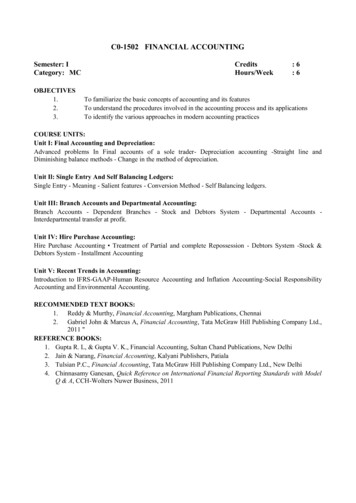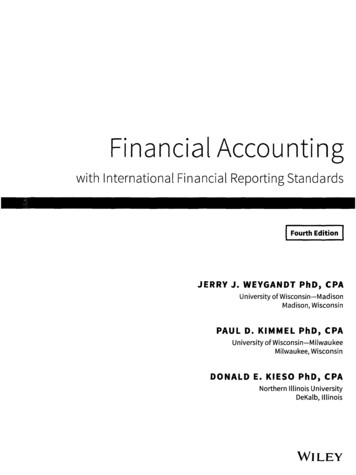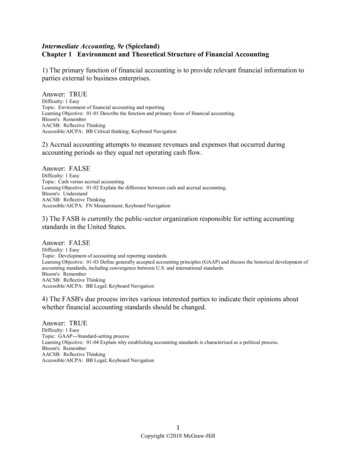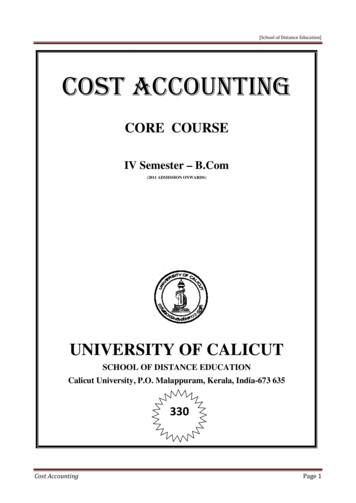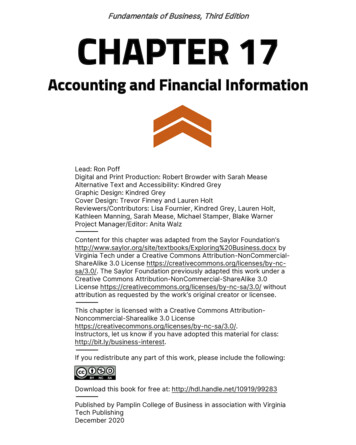
Transcription
Fundamentals of Business, Third EditionCHAPTER 17Accounting and Financial InformationLead: Ron PoffDigital and Print Production: Robert Browder with Sarah MeaseAlternative Text and Accessibility: Kindred GreyGraphic Design: Kindred GreyCover Design: Trevor Finney and Lauren HoltReviewers/Contributors: Lisa Fournier, Kindred Grey, Lauren Holt,Kathleen Manning, Sarah Mease, Michael Stamper, Blake WarnerProject Manager/Editor: Anita WalzContent for this chapter was adapted from the Saylor /Exploring%20Business.docx byVirginia Tech under a Creative Commons Attribution-NonCommercialShareAlike 3.0 License https://creativecommons.org/licenses/by-ncsa/3.0/. The Saylor Foundation previously adapted this work under aCreative Commons Attribution-NonCommercial-ShareAlike 3.0License https://creativecommons.org/licenses/by-nc-sa/3.0/ withoutattribution as requested by the work’s original creator or licensee.This chapter is licensed with a Creative Commons AttributionNoncommercial-Sharealike 3.0 sa/3.0/.Instructors, let us know if you have adopted this material for class:http://bit.ly/business-interest.If you redistribute any part of this work, please include the following:Download this book for free at: http://hdl.handle.net/10919/99283Published by Pamplin College of Business in association with VirginiaTech PublishingDecember 2020
Chapter 17 Accounting and FinancialInformationLearning Objectives Define accounting and explain the differences between managerial accounting and financialaccounting. Identify some of the users of accounting information and explain how they use it. Explain the function of the income statement. Explain the function of the balance sheet. Calculate a break-even point given the necessary information. Evaluate a company’s performance using financial statements and ratio analysis.Apple Inc. is the most valuable company in the world. Thisstatement is based on market value, which in August 2020 was1roughly 1.9 trillion. Although markets can fluctuate, sometimeswildly, if you are reading this chapter for a course only months later,it is unclear whether Apple will have retained or ceded its leadershipposition to Microsoft, which has taken the leadership positionmultiple times since 2018.You may wonder what kind of information is used to make thesedeterminations. How does the market know that Apple should bevalued more than 400 billion higher than Microsoft, for example?2Do investors just make their decisions on instinct? Well, some do,but it’s not a formula for sustained success. In most cases, indeciding how much to pay for a company, investors rely on publishedaccounting and financial information released by publicly-tradedcompanies. This chapter will introduce you to the subject ofaccounting and financial information so you can begin to get anunderstanding for how the valuation process works.Figure 17.1: Amazon’s Headquarters in Seattle,WashingtonChapter 17 Accounting and Financial Information 311
The Role of AccountingAccounting is often called “the language of business” because it communicates so much of the informationthat owners, managers, and investors need to evaluate a company’s financial performance. These people arestakeholders in the business—they’re interested in its activities because they’re affected by them. The financialfutures of owners and other investors may depend heavily on strong financial performance from the business,and when performance is poor, managers may be replaced or laid off in a downsizing. In fact, a key purpose ofaccounting is to help stakeholders make better business decisions by providing them with financial information.You shouldn’t try to run an organization or make investment decisions without accurate and timely financialinformation, and it is the accountant who prepares this information. More importantly, accountants make surethat stakeholders understand the meaning of financial information, and they work with both individuals andorganizations to help them use financial information to deal with business problems. Actually, collecting allthe numbers is the easy part. The hard part is analyzing, interpreting, and communicating the information. Ofcourse, you also have to present everything clearly while effectively interacting with people from every businessdiscipline. In any case, we’re now ready to define accounting as the process of measuring and summarizingbusiness activities, interpreting financial information, and communicating the results to management and otherdecision makers.Fields of AccountingAccountants typically work in one of two major fields. Management accountants provide information andanalysis to decision makers inside the organization in order to help them run it. Financial accountants furnishinformation to individuals and groups both inside and outside the organization in order to help them assessits financial performance. Their primary focus, however, is on external parties. In other words, managementaccounting helps you keep your business running while financial accounting tells the outside world how wellyou’re running it.Management AccountingManagement accounting, also known as managerial accounting, plays a key role in helping managers carry outtheir responsibilities. Because the information that it provides is intended for use by people who perform a widevariety of jobs, the format for reporting information is flexible. Reports are tailored to the needs of individualmanagers, and the purpose of such reports is to supply relevant, accurate, timely information that will aidmanagers in making decisions. In preparing, analyzing, and communicating such information, accountants workwith individuals from all the functional areas of the organization—human resources, operations, marketing, etc.312 Chapter 17 Accounting and Financial Information
Figure 17.2: The Role of Managerial AccountingFinancial AccountingFinancial accounting is responsible for preparing the organization’s financial statements—including theincome statement, the statement of owner’s equity, the balance sheet, and the statement of cash flows—thatsummarize a company’s past performance and evaluate its current financial condition. If a company is tradedpublicly on a stock market such as the NASDAQ, these financial statements must be made public, which is nottrue of the internal reports produced by management accountants. In preparing financial statements, financialaccountants adhere to a uniform set of rules called generally accepted accounting principles (GAAP)—the basicprinciples for financial reporting issued by an independent agency called the Financial Accounting StandardsBoard (FASB). Users want to be sure that financial statements have been prepared according to GAAP becausethey want to be sure that the information reported in them is accurate. They also know that when financialstatements have been prepared by the same rules, they can be compared from one company to another.While companies headquartered in the United States follow US-based GAAP, many companies locatedoutside the United States follow a different set of accounting principles called International FinancialReporting Standards (IFRS). These multinational standards, which are issued by the International AccountingStandards Board (IASB), differ from US GAAP in a number of important ways, but we’re not at the point yet ofChapter 17 Accounting and Financial Information 313
exploring these sometimes fine distinctions. Bear in mind, however, that, according to most experts, a singleset of worldwide standards will eventually emerge to govern the accounting practices of both US and non-UScompanies.Who Uses Financial Accounting Information?The users of managerial accounting information are pretty easy to identify—basically, they’re a firm’s managers.We need to look a little more closely, however, at the users of financial accounting information, and we alsoneed to know a little more about what they do with the information that accountants provide them.Owners and ManagersIn summarizing the outcomes of a company’s financial activities over a specified period of time, financialstatements are, in effect, report cards for owners and managers. They show, for example, whether the companydid or didn’t make a profit and furnish other information about the firm’s financial condition. They alsoprovide some information that managers and owners can use in order to take corrective action, though reportsproduced by management accountants offer a much greater level of depth.Investors and CreditorsInvestors and creditors furnish the money that a company needs tooperate, and not surprisingly, they want to know how that business isperforming. Because they know that it’s impossible to make smartinvestment and loan decisions without accurate reports on anorganization’s financial health, they study financial statements to assessa company’s performance and to make decisions about continuedinvestment.According to the world’s most successful investor, Warren Buffett, thebest way to prepare yourself to be an investor is to learn all theaccounting you can. Buffet, chairman and CEO of Berkshire Hathaway, acompany that invests in other companies, turned an original investment3of 10,000 into a net worth of 66 billion in four decades, and he did it,in large part, by paying close attention to financial accounting reports.314 Chapter 17 Accounting and Financial InformationFigure 17.3: Warren Buffet, PresidentialMedal of Freedom recipient in 2011
Figure 17.4: The Role of Financial AccountingGovernment AgenciesBusinesses are required to furnish financial information to a number of government agencies. Publicly-ownedcompanies, for example—the ones whose shares are traded on a stock exchange—must provide annual financialreports to the Securities and Exchange Commission (SEC), a federal agency that regulates stock tradesand which is charged with ensuring that companies tell the truth with respect to their financial positions.Companies must also provide financial information to local, state, and federal taxing agencies, including theInternal Revenue Service (IRS).Chapter 17 Accounting and Financial Information 315
Other UsersA number of other external users have an interest in a company’s financial statements. Suppliers, for example,need to know if the company to which they sell their goods is having trouble paying its bills or may evenbe at risk of going under. Employees and labor unions are interested because salaries and other forms ofcompensation are dependent on an employer’s performance.Figures 17.2 and 17.4 illustrate the main users of management and financial accounting and the types ofinformation produced by accountants in the two areas. In the rest of this chapter, we’ll learn how to preparea set of financial statements and how to interpret them. We’ll also discuss issues of ethics in the accountingcommunities and career opportunities in the accounting profession.Check Your Understanding with an Online Quizhttps://pressbooks.lib.vt.edu/fundamentalsof business3e/?p 174Understanding Financial StatementsWe hope that, so far, at least one thing is clear: If you’re in business, you need to understand financialstatements. The law no longer allows high-ranking executives to plead ignorance or fall back on delegationof authority when it comes to responsibility for a firm’s financial reporting. In a business environment taintedby episodes of fraudulent financial reporting and other corporate misdeeds, top managers are now being heldresponsible for the financial statements issued by the people who report to them. Top managers need to knowhow well the company is performing. Financial information helps managers identify signs of impending troublebefore it is too late.The Function of Financial StatementsPut yourself in the place of Connie in Figure 17.5 on the next page, who runs Connie’s Confections out of herhome. She loves what she does, and she feels that she’s doing pretty well. In fact, she has an opportunity to takeover a nearby store at very reasonable rent, and she can expand by getting a modest bank loan and investingsome more of her own money. So it’s decision time for Connie: She knows that the survival rate for start-upsisn’t very good, and before taking the next step, she’d like to get a better idea of whether she’s actually doingwell enough to justify the risk. The basic financial statements will give her some answers.Since this book is for an introductory course, we will focus our attention on the income statement andbalance sheet only, even though we mentioned other financial statements earlier in the chapter.316 Chapter 17 Accounting and Financial Information
Toying with a Business IdeaTo bring this concept closer to home, let’s assume that you need to earn money while you’re in college and thatyou’ve decided to start a small business. Your business will involve selling stuff to other college students, andto keep things simple, we’ll assume that you’re going to operate on a “cash” basis: you’ll pay for everything withcash, and everyone who buys something from you will pay in cash.You may have at least a little cash on you right now—some currency, or paper money, and coins. In accounting,however, the term cash refers to more than just paper money and coins. It also refers to the money that youhave in checking and savings accounts and includes items that you can deposit in these accounts, such asmoney orders and different types of checks.Figure 17.5: Three Financial Statements That Can Help Business Owners Keep Track of Sales,Assets, Cash Flow, and Many Other ThingsYour first task is to decide exactly what you’re going to sell. You’ve noticed that with homework, exams, socialcommitments, and the hectic lifestyle of the average college student, you and most of the people you knowalways seem to be under a lot of stress. Sometimes you wish you could just lie back between meals andbounce a ball off the wall. And that’s when the idea hits you: Maybe you could make some money by selling aChapter 17 Accounting and Financial Information 317
product called the “Stress-Buster Play Pack.” Here’s what you have in mind: you’ll buy small toys and other funstuff—instant stress relievers—at a local dollar store and pack them in a rainbow-colored plastic treasure chestlabeled “Stress-Buster.”The Accounting EquationTo begin keeping track of your company financially, you’ll first need to understand the fundamental accountingequation:Assets Liabilities Owner’s EquityThink of assets as things owned by your business—cash in the bank, product inventory, etc. And think ofliabilities as the amounts owed—perhaps you’ve had a job where your pay check came a couple of weeks afteryou did the work; during that unpaid window, the amount due to you was a liability to your employer. Owner’sequity represents the value of the firm according to your financial statements; obviously it is good to own morethan you owe.This simple but important equation highlights the fact that a company’s assets came from somewhere: eitherfrom investments made by the owners (owner’s equity) or from loans (liabilities). This means that the assetsection of the balance sheet on the one hand and the liability and owner’s-equity section on the other must beequal, or balance.Let’s say you have 200 in cash and borrow 400 from your parents and plan to buy a month’s worth ofplastic treasure chests and toys. After that, you’ll use the cash generated from sales of Stress-Buster Play Packsto replenish your supply. You open a bank account for your new business and create your opening financialstatement—the balance sheet.The Balance SheetA balance sheet reports the following information: Assets: the resources from which it expects to gain some future benefit Liabilities: the debts that it owes to outside individuals or organizations Owner’s equity: the investment in the businessAt the time you open the account, your balance sheet would look like this:318 Chapter 17 Accounting and Financial Information
Figure 17.6: Stress-Buster’s Balance Sheet as of September 1,2020Stress-Buster CompanyBalance SheetAs of September 1, 2020Assets 600CashLiabilities and Owner’s EquityLiabilities 400Owner’s Equity 200Total Liabilities and Owner’s Equity 600The amount you owe your parents is a liability to you, and your own investment of 200 in the business isrepresented by your owner’s equity.Now it is time to start buying toys, repackaging them, and selling your Stress-Busters. Each plastic chest willcost 1.00, and you’ll fill each one with a variety of five simple toys, all of which you can buy for 1.00 each.You plan to sell each Stress-Buster Play Pack for 10 from a rented table stationed outside a major dining hall.Renting the table will cost you 20 a month. In order to make sure you can complete your school work, youdecide to hire fellow students to staff the table at peak traffic periods. They’ll be on duty from noon until 2:00p.m. each weekday except Fridays, and you’ll pay them a generous 7.50 an hour. Wages, therefore, will cost you 240 a month (2 hours 4 days 4 weeks 32 hours 7.50). Finally, you’ll run ads in the college newspaper ata monthly cost of 40. Thus your total monthly costs will amount to 300 ( 20 240 40).The Income StatementLet’s say that during your first month, you sell 100 play packs. Not bad, you say to yourself, but did I make aprofit? To find out, you prepare an income statement showing revenues, or sales, and expenses—the costs ofdoing business. You divide your expenses into two categories: Cost of goods sold: the total cost of the goods that you’ve sold Operating expenses: the costs of operating your business except for the costs of things that you’ve sold.Now you need to do some subtracting: The difference between sales revenue and cost of goods sold is your gross profit, also known as grossmargin.Chapter 17 Accounting and Financial Information 319
The difference between gross profit and operating expenses is your net income or profit, which is theproverbial “bottom line.” Note we’ve assumed you’re making money, but businesses can also have a netloss.Figure 17.7 is your income statement for the first month. (Remember that we’ve made things simpler by handlingeverything in cash.)Figure 17.7: Stress-Buster’s Income Statement forSeptember 2020Stress-Buster CompanyIncome StatementMonth Ended September 30, 2020Sales (100 x 10.00) 1,000Less cost of goods sold (100 x 6) 600Gross profit (100 x ( 10 - 6) ) 400Less operating expensesSalaries 240Advertising 40Table rental 20 300Net income (Profit) ( 400- 300) 100Did You Make Any Money?What does your income statement tell you? It has provided you with four pieces of valuable information: Yousold 100 units at 10 each, bringing in revenues or sales of 1,000.Each unit that you sold cost you 6— 1 for the treasure chest plus 5 toys costing 1 each. So your cost ofgoods sold is 600 (100 units 6 per unit).Your gross profit—the amount left after subtracting cost of goods sold from sales—is 400 (100 units 4each).After subtracting operating expenses of 300—the costs of doing business other than the cost of productssold—you generated a positive net income or profit of 100.Whereas your balance sheet tells you what you have at a specific point in time, your income statement tellsyou how much income you earned over some period of time, in this case, the month of September.320 Chapter 17 Accounting and Financial Information
Check Your Understanding with an Online Quizhttps://pressbooks.lib.vt.edu/fundamentalsof business3e/?p 174Companies prepare financial statements on at least a 12-month basis—that is, for a fiscal year which endson December 31 or some other logical date, such as June 30 or September 30. Fiscal years can vary becausecompanies generally pick a fiscal-year end date that coincides with the end of a peak selling period; thus acrabmeat processor might end its fiscal year in October, when the crab supply has dwindled. Most companiesalso produce financial statements on a quarterly or monthly basis. For Stress-Buster, you’ll want to preparethem monthly to stay on top of how your new business is doing. Let’s prepare a new balance sheet to how thingshave changed by the end of the month.Recall that Stress-Buster earned 100 during the month of September and that you decided to leave theseearnings in the business. This 100 profit increases two items on your balance sheet: the assets of the company(its cash) and your investment in it (its owner’s equity). Figure 17.8 shows what your balance sheet will look likeon September 30. You now have 700 in cash: 400 that you borrowed plus 300 that you’ve invested in thebusiness (your original 200 investment plus the 100 profit from the first month of operations, which you’vekept in the business).Figure 17.8: Stress-Buster’s Balance Sheet at the End ofSeptember 2020Stress-Buster CompanyBalance SheetAs of September 30, 2020AssetsCash (original 600 plus 100 earned) 700Liabilities and Owner’s EquityLiabilities 400Owner’s Equity ( 200 invested by owner plus 100 profits retained) 300Total Liabilities and Owner’s Equity 700A Quick Word about CreditBecause the money you borrowed came from your trusting parents, they loaned it to you on the basis of yousigning a simple note promising to pay it back. Such a loan is considered unsecured credit. But what if you hadChapter 17 Accounting and Financial Information 321
borrowed the money from a bank? The banker would probably have required collateral, which is property orsome other asset that would become the property of the lender if you failed to pay. If you know someone whohad a car loan, you probably know that if the loan went unpaid, the bank could repossess the car. This type ofloan is called secured credit, because the bank makes it with the security that if the borrower cannot or will notpay, they can take possession of the collateral, sell it, and recover their money that way.Breakeven AnalysisLet’s take a short detour to see how Stress Buster’s financial information might be put to use. As you look at yourfirst financial statements, you might ask yourself: is there some way to figure out the level of sales you needto avoid losing money—to “break even”? This can be done using breakeven analysis. To break even (have noprofit or loss), your total sales revenue must exactly equal all your expenses (both variable and fixed). Variablecosts depend on the quantity produced and sold; for example, each Stress-Buster includes the treasure chestand the toys inside. Fixed costs don’t change as the quantity sold changes; for example, you’ll pay for youradvertising whether you sell Stress-Busters or not. The balance between revenue and expenses will occur whengross profit equals all other (fixed) costs. To determine the level of sales at which this will occur, you need to dothe following (using data from the previous example):1. Determine your total fixed costs: Fixed costs 240 salaries 40 advertising 20 table 3002. Identify your variable costs on a per-unit basis: Variable cost per unit 6 ( 1 for the treasure chest and 5 for the toys)3. Determine your contribution margin per unit: selling price per unit—variable cost per unit: Contribution margin 10 selling price— 6 variable cost per unit 44. Calculate your breakeven point in units: fixed costs / contribution margin per unit: Breakeven in units 300 fixed costs / 4 contribution margin per unit 75 unitsYour calculation means that if you sell 75 units, you’ll end up with zero profit (or loss) and will exactly breakeven. To test your calculation, you can prepare a what-if income statement for75 units in sales (your breakeven number). The resulting statement is shown in Figure 17.9.Of course you want to do better than just break even, so you could modify this analysis to a targeted levelof profit by adding that amount to your fixed costs and repeating the calculation. Breakeven analysis is ratherhandy. It enables you to determine the level of sales that you must reach to avoid losing money and the level ofsales that you have to reach to earn a certain profit. Such information will be vital to planning your business.322 Chapter 17 Accounting and Financial Information
Figure 17.9: Stress-Buster’s Breakeven Income StatementStress-Buster CompanyIncome StatementMonth Ended September 30, 2020(at break even level of sales 75 units)Sales (75 x 10.00) 750Less cost of goods sold (75 x 6) 450Gross profit ( 75x ( 10 – 6) ) 300Less operating expensesSalaries 240Advertising 40Table rental 20 300Net income (Profit) ( 300- 300) 0Financial Statement AnalysisNow that you know a bit about financial statements, we’ll spend a little time talking about they’re used tohelp owners, managers, investors, and creditors assess a firm’s performance and financial strength. You canglean a wealth of information from financial statements, but first you need to learn a few basic principles for“unlocking” it.Types of Financing Used by CompaniesBefore we go any further, let’s outline two basic forms of financing—i.e., how do companies get the money theyneed in order to operate? One way is to borrow the money, which is known as debt financing. A business mighttake a loan from a commercial bank, or it might issue bonds which pay a particular rate of interest over a setperiod of time. At the end of the life of the bond, the borrower would repay the principal, i.e., the amountborrowed, to the holders of those bonds. Another form of financing would be to sell an ownership stake in thecompany, which is known as equity financing. Many business owners are reluctant to part with an ownershipChapter 17 Accounting and Financial Information 323
stake in the company because they then have to share the profits with those who have purchased a share of thecompany. However, lenders will only provide so much financing before they begin to get concerned about theborrower’s ability to repay, so in practice, most businesses use some combination of debt and equity financingto fund the operations of the company.Trend Analysis from the Income StatementNow let’s look at some of the things we can learn from analyzing financial statements. Figure 17.10 is anabbreviated financial statement for Apple for 2014 taken directly from their website. You will note that insteadof showing only the current year’s results, the company has shown data for the prior two years as well.From this relatively simple exhibit, considerable information about Apple’s performance can be obtained. Forexample: Apple sales grew at 6.95 percent from 2013 to 2014, not bad for a company with such a large base of salesalready, but certainly not the rapid-growth company it once was. Net income as a percent of sales (a ratio also known as return on sales) was 21.6 percent—or in otherwords, for every 5 in sales, Apple turned more than 1 of it into profit. That is substantial!Many other calculations are possible from Apple’s data, and we will look at a few more as we explore ratioanalysis.324 Chapter 17 Accounting and Financial Information
Figure 17.10: Apple Statement of Operations, 2019. (In millions, except number of shares which are reflected in thousands and pershare amounts)Year endedSeptember 30,2017September 29, 2018September 28,2019Net sales 229,234 265,595 260,174Cost of sales 141,048 163,756 161,782Gross margin 88,186 101,839 98,392Research and development 11,581 14,236 16,217Selling, general and administrative 15,261 16,705 18,245Total operating expenses 26,842 30,941 34,462Operating income 61,344 70,898 63,930Other income/(expense), net 2,745 2,005 1,807Taxes 64,089 72,903 65,737Provision for income taxes 15,738 13,372 10,481Net income 48,351 59,531 55,256Basic 9.27 12.01 11.97Diluted 9.21 11.91 11.89Basic 5,217,242 4,955,377 4,617,834Diluted 5,251,692 5,000,109 4,648,913 2.72 3.0Operating expenses:Income before provision for income:Earnings per share:Shares used in computing earnings pershare:Cash dividends declared per common share: 2.4Ratio AnalysisHow do you compare Apple’s financial results with those of other companies in your industry or with the othercompanies whose stock is available to investors? And what about your balance sheet? Are there relationships onthis statement that also warrant investigation? These issues can be explored by using ratio analysis, a techniquefor evaluating a company’s financial performance.Remember that a ratio is just one number divided by another, with the result expressing the relationshipbetween the two numbers. It’s hard to learn much from just one ratio, or even a number of ratios covering thesame period. Rather, the deeper value in ratio analysis lies in looking at the trend of ratios over time and incomparing the ratios for several time periods with those of other companies. There are a number of differentways to categorize financial ratios.Here’s one set of categories:Chapter 17 Accounting and Financial Information 325
Profitability ratios tell you how much profit is made relative to the amount invested (return oninvestment) or the amount sold (return on sales). Liquidity ratios tell you how well positioned a company is to pay its bills in the near term. Liquidity refersto how quickly an asset can be turned into cash. For example, share of stock is substantially more liquidthan a building or a machine. Debt ratios look at how much borrowing a company has done in order to finance the operations of thebusiness. The more borrowing, the more risk a company has taken on, and so the less likely it would be fornew lenders to approve loan applications. Efficiency ratios tell you how well your assets are being managed.We could employ many different ratios, but we’ll focus on a few key examples.Profitability Ratio
Figure 17.2: The Role of Managerial Accounting Financial Accounting Financial accounting is responsible for preparing the organization’s financial statements—including the income statement, the statement of owner’s equity, the balance sheet, and the statement of cash flows—that summarize a company’s past performa

